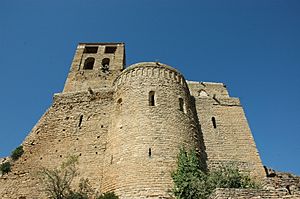Arnau Mir de Tost facts for kids
Arnau Mir de Tost (born around 1000 – died after 1072) was an important nobleman from Catalonia. He was a lord of Llordà and viscount of Àger in the County of Urgell. Arnau was a key leader during the Reconquista in Catalonia in the 11th century. This was a time when Christian kingdoms were taking back land from Muslim rule in Spain. People sometimes call him the "El Cid of the Lands of Lleida" because he helped bring Christian rule back to that area.
Contents
Early Life and Rise to Power
Arnau was born in a place called Tost shortly after the year 1000. His father died when he was young. Arnau then joined the court of Count Ermengol II.
In 1031, Arnau married a woman named Arsenda. He bought the rights to the castle of Llordà from the count. This castle was on the border with the Muslim lands.
Conquering New Lands
From his base at Llordà, Arnau began to conquer new territories. This happened after the large Muslim caliphate broke into many smaller states called taifas. He conquered the Conca Dellà region. He also pushed the border of Urgell up to the Montsec mountains.
His biggest achievement was capturing the strong fortress of Àger in 1034. Àger was a very important Muslim stronghold. It was a key part of their defense line against Urgell. Arnau successfully captured it twice.
Lord of Àger and Castle Builder
After Arnau captured Àger, Count Ermengol made him the lord of the area. Arnau was given the job of repopulating the land. This area had been damaged by the fighting between Christians and Muslims.
To help people settle, Arnau created special rules. These rules explained how people could live and work in the new lands. The Montsec area became the center of a new Christian region.
Arnau had a skilled scribe named Vidal. Vidal helped Arnau write important documents. These documents were called convenientia (conventions). They were agreements that became common in western Catalonia.
Family Alliances
Arnau also extended his power through his family. His daughter, Valença, married Raymond IV of Pallars Jussà. This marriage happened in 1055. Through this alliance, Arnau gained influence in the County of Pallars Jussà. Raymond even promised Arnau four castles. This was an assurance that he would keep his marriage vows.
At the peak of his power, Arnau controlled over thirty castles. He also held many farming settlements. This showed why he was called a viscount and a comtor. He built a strong monastery called Sant Pere d'Àger. This monastery still stands today on a hill overlooking Àger.
Political Influence and Later Life
In 1043–1044, Arnau became a hostage for his lord, Ermengol III of Urgell. This was part of a deal for 4,000 solidi (a type of coin). It was an agreement between Ermengol III and Raymond Berengar I of Barcelona. This deal was to ensure their alliance against Raymond of Cerdanya.
Arnau also fought for Raymond Berengar. He conquered the towns of Camarasa and Cubells for him. By 1050, Arnau had secured a promise from Raymond Berengar. This promise meant Raymond Berengar would not demand lodging rights from Arnau. At the same time, Arnau gained more power from Ermengol III. This reduced the count's rights over Arnau's castles.
Crusades and Legacy
Arnau strongly supported the Crusade of Barbastro in 1064. On April 17, 1066, Ermengol III died defending Barbastro from Muslims. Arnau then became the regent for the young Ermengol IV of Urgell. This meant Arnau ruled Urgell until Ermengol IV was old enough.
In 1072, Arnau went on a pilgrimage to Santiago de Compostela. When he returned, he wrote his will. This will is still preserved today. It mentions a set of ninety-six rock crystal chess pieces. These are known as the "Urgell (or Àger) chessmen." They were first mentioned in his wife Arsenda's will in 1068. These chess pieces have an abstract Islamic design. This suggests they came from the Muslim lands to the south.
It is said that on his deathbed, Arnau wished he had more time. He wanted to conquer Balaguer and Lleida. A small monument has been built to honor Arnau at Foradada, near Montsonís.
See also
 In Spanish: Arnal Mir de Tost para niños
In Spanish: Arnal Mir de Tost para niños


